Provenance Studies of a Set of Pick-Up Glass Fragments Found in Portugal and Dated to the 17th Century
Abstract
1. Introduction
Archeological Context and Material
- Santa Clara-a-Velha monastery (SCV), is known to be the archeological site with the largest assemblage of millefiori glass fragments ever found around the world [1] (Supplementary Material). Here, new decorative patterns, glass colors, and shapes were observed [19].
- São João de Tarouca monastery (SJT) was selected because a small, fragmented millefiori flask decorated with the particular “cross of Christ” pattern and a small fragment belonging to a rim and part of the wall of a blue glass vessel decorated with rosette pattern (Figure 3) were found here.The SJT site is the oldest Portuguese Cistercian monastery, and it was classified as a National Monument in 1956 [25]. It is connected to the French Clairvaux monastery, with its first documentation dating back to 1144 [26]. The connection with glass working of the Cistercian Order are reported in some documents that mentioned that they were able to make small objects like paternosters and “pilgrimage hardware” [27].These fragments were dated to the 17th century, and the symbol of the cross of Christ was adopted by the Military Order of Our Lord Jesus Christ, which inherited, in Portugal, all the heritage that belonged to the Templar Order [28]. This cross, also known as the Portuguese cross, is an important symbol for Portuguese identity, being used on contemporary coins, in the caravel sails, and architectural ornaments [29].
2. Methodology
2.1. Sample Selection and Preparation
2.2. UV–Vis Absorbance and Reflectance Spectroscopy
2.3. µ-Raman Spectroscopy
2.4. µ-PIXE
2.5. LA-ICP-MS
3. Results and Discussion
3.1. Base Glass
3.1.1. Alkali Sources
3.1.2. Silica Sources
- Clear: SCV (394).
- Blue: SCV (250, 364, 366, and 394).
- Red: SCV (235, 250, 275 and 329).
- Turquoise: (SCV_364 and SCV_366).
- White: SCV (232, 250, 329, 360, 364, and 394); SJT (01 and 09).
3.2. Geochemical Patterns
3.2.1. Normalization to Upper Earth
3.2.2. Carbonaceous Chondrite Normalization
3.3. All Layers Together
3.3.1. Naturally Colored Glass
3.3.2. Colored Glass Layers
BLUE
GREEN
PURPLE
RED
TURQUOISE
WHITE
3.4. Morphological Characterization of Millefiori Fragments
3.5. Summary
- Could it be that this is true for colorless glass but does not apply to colored glass, since a greenish tint may not have much influence on the final color of cobalt blue or copper red, for instance? The truth is that purified Levantine ashes were detected in clear (3 layers), blue- (2 layers), and white (2 layers)-colored glass and in clear (2 layers), blue- (2 layers), red- (2 layers), turquoise- (1 layer), and white (1 layer)-colored glass made with unpurified Levantine ashes (Table 4).
- Blue is mainly influenced by Co2+, while Cu2+, Fe2+/3+, and MnO were also detected in some samples.
- Green is produced due to an equilibrium between Fe2+ and Fe3+ ions.
- Purple was only observed once (SCV_368 sample), and Co2+ and MnO contributed to the final color.
- Red was formed under reduced conditions which favored the development of cupper nanoparticles of Cu0 and Cu2O dispersed in the glass matrix.
- Turquoise was achieved in an oxidizing environment which favored the development of Cu2+ ions.
- White glass layers were obtained by the addition of lead and tin oxides to the base glass, favoring the growing of cassiterite and malayaite crystals.
4. Conclusions and Future Work
Supplementary Materials
Author Contributions
Funding
Data Availability Statement
Acknowledgments
Conflicts of Interest
References
- Pulido Valente, F.; Coutinho, I.; Medici, T.; Vilarigues, M. Glass colored by glass: Review of the pick-up decoration in early modern Europe. J. Archaeol. Sci. Rep. 2021, 36, 102832. [Google Scholar] [CrossRef]
- Wood, P. The tradition from Medieval to Renaissance. In The History of Glass; Klein, D., Lloyd, W., Eds.; LITTLE, Brown and Company: London, UK, 2000; pp. 67–91. [Google Scholar]
- Baumgartner, E. Gobelets “a millefiori a” croix de malte. In Bernard Perrot (1640–1709): Secrets et Chefs-D’oeuvre des Verreries Royales d’Orléans; Somogy Editions’ D’Art, Publications du Vitrocentre Romont (Bern: Lang), 2010; pp. 67–77. [Google Scholar]
- Whitehouse, D. Renaissance and Modern Europe 1450-1900. In Glass, a Short History; Whitehouse, D., Ed.; The British Museum in Association with the Corning Museum of Glass: Corning, NY, USA, 2012; pp. 65–86. [Google Scholar]
- Moretti, C. Vetro Mosaico, millefiori, murrine. Boll. dei Civ. Musei Veneziani d’Arte e di Stor. 1985, 29, 5–21. [Google Scholar]
- Spenlé, V. Venezianische glas in Fürstlichen Kunst- und wunderkammern des 16. Und 17. Jahrhunderts/Venetian Glass in the 16th and 17th century princely Kunstand Wunderkammer. In The White Gold of Venice; Laue, G., Ed.; Filigree Glass for European Kunstkammer; Kunstkammer Georg Laue: München, Germany, 2014; pp. 40–65. [Google Scholar]
- Medici, T. Vidros da Terra. O vidro tardomedieval e moderno em Portugal (séculos XIV-XVII). O Contributo da Arqueologia. A Thesis Submitted in Fulfilment of the Requirements of Universidade de Coimbra for the Degree of Doctor of Archaeology. Faculdade de Letras da Universidade de Coimbra. 2014. Available online: https://estudogeral.sib.uc.pt/handle/10316/26739 (accessed on 10 September 2024).
- Amado Mendes, J. Hitória Do Vidro e Do Cristal em Portugal; Edições Inapa: Lisbon, Portugal, 2002. [Google Scholar]
- Valente, V. O Vidro em Portugal; Portucalense Editora: Porto, Portugal, 1950. [Google Scholar]
- Coutinho, I.; Cambil Campaña, I.; Alves, L.C.; Medici, T. Callen horno del vidrio–preliminary study of glass production remains found in Granada, Spain, dated to the 16th and 17th centuries. Minerals 2021, 11, 688. [Google Scholar] [CrossRef]
- Baart, J.M. The façon de Venise glass of Amsterdam. In Majolica and Glass: From Italy to Antwerp and Beyond. The Transfer of Technology in the 16th–early 17th Century; Veeckman, J., Ed.; Stad Antwerpen: Antwerpen, Belgium, 2002; pp. 161–171. [Google Scholar]
- Gawronski, J.; Hulst, M.; Jayasena, R.; Veerkamp, J. Glasafval op het achtererf, AAR50 (Amsterdamse Archeologische Rapporten). 2010. Available online: https://www.academia.edu/5915086/Glasafval_op_het_achtererf_Amsterdamse_Archeologische_rapporten_50 (accessed on 10 September 2024).
- Henkes, H.E. Glas zonders glans. Vijf gebruicksglas uit de bodem van de Lage Landen 1300–1800/Glass without gloss. In Utility Glass from Five Centuries Excavated in the Low Country 1300–1800; Coördinatie Commissie van Advies Inzake Archeologisch Onderzoek Binnen Het Ressort: Rotterdam, The Netherlands, 1994. [Google Scholar]
- Hulst, M. In de zeventiende eeuw was Amsterdam een belangrijk productiecentrum van kleurloos luxe glaswerk, het façon de Venise. Hoewel in Netherland opgegraven façon de Venise steevast aan Amsterdamse glasovens wordt toegeschreven, bleef de identificatie ervan tot voor kort onzeker. In Glazen Met Maskerons en Leeuwenkopstammen uit Amsterdamse Bodem. Een Aanzet tot de Identificatie van Zeventiende-Eeuwse Amsterdamse Façon de Venise; 2013; pp. 21–38. Available online: https://www.academia.edu/5881032/Glazen_met_maskerons_en_leeuwenkopstammen_uit_Amsterdamse_bodem (accessed on 10 September 2024).
- Dungworth, D.; Cromwell, T.; Ashurst, D.; Cumberpatch, C.; Higgins, D.; Willmott, H. Glass and pottery manufacture at Silkstone Yorkshire. Post-Medieval Archaeol. 2006, 40, 160–190. [Google Scholar] [CrossRef]
- Barosa, J.P. Fabrico do Vidro e Vidreiros de Portugal: Do século XV ao Longo do Século XVII (1438–1714). 2022. Available online: https://www.researchgate.net/publication/361665458_Fabrico_do_Vidro_e_Vidreiros_em_Portugal_ca_1439_-_1714 (accessed on 10 September 2024).
- Coutinho, I.; Medici, T.; Wiley, R.; Alves, L.C.; Gratuze, B.; Vilarigues, M. The Gourd-Shaped Vessel: A Portuguese Product? J. Glass Stud. 2017, 59, 215–234. [Google Scholar]
- Pulido Valente, F.; Coutinho, I.; Medici, T.; Gratuze, B.; Alves, L.C.; Varela Gomes, R.; Varela Gomes, M.; Vilarigues, M. In the quest for historical Lisbon through 17th century Millefiori glass. J. Archaeol. Sci. Rep. 2023, 52, 104228. [Google Scholar] [CrossRef]
- Pulido Valente, F.; Varela Gomes, R.; Varela Gomes, M.; Coutinho, I.; Medici, T.; Vilarigues, M. Renaissance millefiori glass: The Portuguese case study. In Interim Meeting of ICOM-CC, Glass and Ceramics Working Group; Conference Proceedings; Mandrus, J., Schussler, V., Eds.; ICOM: London, UK, 2019; pp. 217–221. [Google Scholar]
- Lima, A.; Medici, T.; Pires de Matos, A.; Verità, M. Chemical analysis of 17th century Millefiori glasses excavated in the Monastery of Sta. Clara-a-Velha, Portugal: Comparison with Venetian and façon-de-Venise production. J. Archaeol. Sci. 2012, 39, 1238–1248. [Google Scholar] [CrossRef]
- Coutinho, I.; Medici, T.; Alves, L.C.; Gratuze, B.; Vilarigues, M. Provenance studies on façonde-de-Venise glass excavated in Portugal. J. Archaeol. Sci. Rep. 2016, 7, 437–448. [Google Scholar] [CrossRef]
- Varela, M.R. Estudos de Proveniência de um Conjunto de Vidros Filigranados Datados dos Séculos XVI–XVII Encontrados no Largo do Chafariz de Dentro, Lisboa. Master’s Thesis, Faculdade de Ciências e Tecnologia, Universidade Nova de Lisboa, Monte de Caparica, Portugal, 2018. Available online: https://run.unl.pt/bitstream/10362/68861/1/Varela_2018.pdf (accessed on 10 September 2024).
- Trindade, S.D.; Gambini, L.I. Mosteiro de Santa Clara de Coimbra: Do Convento à Ruína, da Ruína à Contemporaneidade. Côrte-Real, Artur (coord.), 2nd ed.; Direção Regional da Cultura do Centro: Coimbra, Portugal, 2009; Available online: https://www.academia.edu/21876251/Mosteiro_de_Santa_Clara_de_Coimbra_do_convento_%C3%A0_ru%C3%ADna_da_ru%C3%ADna_%C3%A0_contemporaneidade (accessed on 10 September 2024).
- Varela Gomes, M.; Varela Gomes, R.; Casimiro, T.M. Convents, monasteries and porcelains: A case study of Santana Convent, Lisbon. In Global Pottery Proceedins–1st International Conference for Historical Archaeological and Archaeometry for Societies in Contact; Garrigós, J.B., Fernández, M.M., Iñañez, J.G., Eds.; BAR International Series; Archaeopress: Oxford, UK, 2015; Volume 2761, pp. 93–101. [Google Scholar]
- Barroso Catalão, S. Mosteiro de São João de Tarouca e a Arqueologia da Arquitectur: O «Aljube». Museu de Lamego, Direcção Regional da Cultura do Norte; 2018; ISBN 978-989-99516-5-5. Available online: https://issuu.com/066239/docs/msjt_aljube_catalaosofia2018 (accessed on 10 September 2024).
- Sampaio e Castro, A.; Sebastian, L. Imtervenção Arqueológicano no Mosteiro de São João de Tarouca: 1998–2001; Estudos: Património, Estudos/Património; IPPAR—Departamento de Estudos: Lisboa, Portugal, 2002; n.º 2; pp. 33–42. [Google Scholar]
- Bellanger, J.; de Venise, L.P.; Massin, C. (Eds.) Histoire du Verre, L’Aube des Temps Modernes: 1453–1672, 1st ed.; Massin Editor: Reims, France, 2006; Volume 3, pp. 25–28. Available online: https://www.amazon.fr/Histoire-verre-Laube-modernes-1453-1672/dp/2707205214 (accessed on 10 September 2024).
- Albuquerque Carreira, J. Cister, os Templários e a Ordem de Cristo. In I Colóquio Internacional; Albuquerque Carreira, J., Rossi Vairo, G., Eds.; Instituto Politécnico de Tomar: Tomar, Portugal, 2012; pp. 21–30. [Google Scholar]
- Vasconcelos, M.A.; Mantero, I. A Monarquia Portuguesa: Reis e Rainhas na História de um Povo; Selecções do Reader’s Digest: Lisbon, Portugal, 1999; ISBN 972-609-261-2. [Google Scholar]
- Fernandes, A. Iluminando o Passado: Estudos do Conjunto de Lamparinas em Vidro do Mosteiro de São João de Tarouca, séculos XVII–XVIII. NOVA Doctoral School of Science and Technology. Master Dissertation, Universidade NOVA de Lisboa, Lisbon, Portugal, 2020. Available online: https://run.unl.pt/bitstream/10362/158344/1/Fernandes_2021.pdf (accessed on 10 September 2024).
- Ferreira, M. Espólio vítreo proveniente da estação arqueológica do Mosteiro de Sta. Clara-a-Velha de Coimbra: Resultados preliminares. Rev. Port. Arqueol. 2004, 7, 541–583. [Google Scholar]
- Medici, T. Revisiting the “Moura Glass Treasure”: New Data about 17th Century Glass in Portugal; Annales du 18e Congrès de l’Association Internationale pour l’Histoire du Verre (AIHV): Thessaloniki, Greece, 2012; pp. 442–447. [Google Scholar]
- Pulido Valente, F.; Coutinho, I.; Vilarigues, M.; Medici, T. A 16th–17th Century Filigrana glass found in Portugal: Some preliminary observations. In Proceedings of the Study days on Venetian Glass, Venetian Filigrana Glass through the Centuries, Venice, Italy, 11–13 September 2017; ATTI, Classe di scienze fisiche, matematiche e naturali. 2018; Volume 176, pp. 139–152. [Google Scholar]
- Gratuze, B. Glass characterization using Laser Ablation Inductively Coupled Plasma Mass Spectrometry. In Mothern Methods for Analysing Archaeological and Historical Glass; Janssens, K., Ed.; Wiley: Chichester, UK, 2013; pp. 200–234. [Google Scholar]
- Gratuze, B. Glass characterization using Laser-Ablation-Inductively Coupled Plasm-Mass Spectroscopy method. In Recent Advances in Laser Ablation ICP-MS for Archaeology (coll. Natural Sciences in Archaeology); Dussubieux, L., Golitko, M., Gratuze, B., Eds.; Springer: Berlin/Heidelberg, Germany, 2016; pp. 602–613. [Google Scholar]
- Biron, I.; Veritá, M. Analytical investigation on Renaissance Venetian enamelled glasses from the Louvre collections. J. Archael. Sci. 2012, 38, 2706–2713. [Google Scholar] [CrossRef]
- Thornton, D.; Freestone, I.; Gudenrath, W.; Bertini, M.; Meek, A.; Ling, D. The technical study of a rare Venetian turquoise glass goblet from the Waddesdon Bequest. In British Museum Technical Research Bulletin; The British Museum: London, UK, 2014; Volume 8, pp. 1–11. [Google Scholar]
- Cagno, S.; Brondi Badano, M.; Mathis, F.; Strivay, D.; Janssens, K. Study of glass fragments from Savona (Italy) and their relation with the glass produced in Altare. J. Archaeol. Sci. 2012, 39, 2191–2197. [Google Scholar] [CrossRef]
- Janssens, K.H.; De Raedt, I.; Schalm, O.; Veeckman, J. Composition of 15-17th century archaeological glass vessels excavated in Antwerp, Belgium. Mikrochim. Acta [Suppl.] 1998, 15, 253–267. [Google Scholar]
- Wouters, H.; Fontaine, C. The large Catalonian Ewer from the Glass Museum of Liège (Second Half of the 16th Century–Beginning of the 17th Century): Restauration and Scientific Analysis. In Proceedings of the Annales du 17e Congrès de l’Association Internationale pour l’Histoire Du Verre (AIHV), Antwerp, Belgium, 4–8 September 2006; pp. 408–413. [Google Scholar]
- Cagno, S.; De Raedt, I.; Jeffries, T.; Janssens, K. Composition of Façon-de-Venise Glass from Early 17th Century London in Comparison with Luxury Glass of the Same Age; Integrated Approaches to the Study of Historical Glass: Brussels, Belgium, 2012; p. 842205. [Google Scholar] [CrossRef]
- Verità, M. Venetian soda glass. In Modern Methods for Analysing Archaeological and Historical Glass, Vol. I; Janssens, K., Ed.; Wiley: Chichester, UK, 2013; pp. 515–536. [Google Scholar]
- Verità, M.; Toninato, T. A Comparative Analytical Investigation on the Origins of the Venetian Glassmaking; Rivista della Stazione Sperimentale del Vetro 4: Venezia, Italy, 1990. [Google Scholar]
- Moretti, C.; Hreglich, S. Raw materials, recipes and procedures used for glass making. In Modern Methods for Analysing Archaeological and Historical Glass; Janssens, K., Ed.; John Wiley & Sons: Hoboken, NJ, USA, 2013. [Google Scholar]
- Verità, M. L’invenzione del Cristallo Muranese: Una Verifica Analitica Delle Fonti Storiche; Rivista della Stazione Sperimentale del Vetro 1: Venezia, Italy, 1985; pp. 17–29. [Google Scholar]
- Verità, M.; Zecchin, S. Thousand years of venetian glass: The evolution of chemical composition from the origins to the 18th century. In Annales de l’Association Internationale pour l’Histoire du Verre 17, Antwerp 2006; Janssens, K., Degryse, P., Cosyns, P., Caen, J., Vańt dack, I., Eds.; University Press Antwerp: Antwerp, Belgium, 2009; pp. 602–613. [Google Scholar]
- De Raedt, I.; Janssens, K.; Veekman, J. On the distinction between 16th and 17th century Venetian and façon-de-venise glass. In Majolica and Glass–from Italy to Antwerp and Beyond. The Transfer of Technology in the 16th–Early 17th Century, Antwerp; Veeckman, J., Jennings, S., Dumortier, C., Whitehouse, D., Verhaeghe, F., Eds.; 2002; pp. 95–154. [Google Scholar]
- Šmit, Ž.; Stamati, F.; Civic, N.; Vevecka-Priftaj, A.; Kos, M.; Jezersek, D. Analysis of Venetian-type glass fragments from the ancient city of Lezha (Albania). Nucl. Instrum. Methods Phys. Res. B 2009, 267, 2538–2544. [Google Scholar] [CrossRef]
- Cagno, S.; Mendera, M.; Jeffries, T.; Janssens, K. Raw materials for medieval to post-medieval Tuscan glassmaking: New insight from LA-ICP-MS analyses. J. Archaeol. Sci. 2010, 37, 3030–3036. [Google Scholar] [CrossRef]
- Schibille, N.; Sterrett-Krause, A.; Freestone, I.C. Glass groups, glass supply and recycling in late Roman Carthage. Archaeol Anthropol Sci 2017, 9, 1223–1224. [Google Scholar] [CrossRef]
- Kunicki-Goldfinger, J.; Hulst, M. The golden age of Amsterdam glass. A chemical and typological approach to recognize Amsterdam 17th century glass production. In Proceedings of the Annales du 20e Congrès de l’Association Internationale pour l’Histoire du Verre (AIHV), Romont, Switzerland, 7–11 September 2015; pp. 547–553. [Google Scholar]
- Verità, M.; Zecchin, S. Scientific investigation of a Venetian polychrome goblet of the 16th century. J. Glass Stud. 2008, 50, 97–104. Available online: https://www.jstor.org/stable/24191019 (accessed on 10 September 2024).
- De Raedt, I.; Janssens, K.; Veekman, J.; Vincze, L.; Vekemans, B.; Jeffries, T.E. Trace analysis for distinguishing between Venetian and façon-de-Venise glass vessels of the 16th and 17th century. J. Anal. At. Spectrom. 2001, 16, 1012–1017. [Google Scholar] [CrossRef]
- Lazar, I.; Willmott, H. The glass from the Gnalić wreck. In Annales Mediterranea; Koper, Slovenia, 2006; Available online: https://www.academia.edu/300405/The_Glass_from_the_Gnali%C4%87_Wreck (accessed on 10 September 2024).
- Šmit, Ž.; Janssens, K.; Bulska, E.; Wagner, B.; Kos, M.; Lazar, I. Trace element fingerprinting of façon-de-Venise glass. Nucl. Instrum. Methods Phys. Res. B 2005, 239, 94–99. [Google Scholar] [CrossRef]
- Brems, D.; Degryse, P. Trace element analysis in provenancing roman glassmaking. Archaeometry 2014, 56, 116–136. [Google Scholar] [CrossRef]
- Costa, M.; Barrulas, P.; Dias, L.; Lopes, M.C.; Barreira, J.; Clist, B.; Karklins, K.; Jesus, M.P.; Silva Domingues, S.; Vandenabeele, P.; et al. Multi-analytical approach to the study of the European glass beads found in the tombs of Kulumbimbi (Mbanza Kongo, Angola). Microchem. J. 2019, 149, 103990. [Google Scholar] [CrossRef]
- Costa, M.; Barrulas, P.; Dias, L.; Lopes, M.C.; Barreira, J.; Clist, B.; Karklins, K.; Jesus, M.P.; Silva Domingues, S.; Moens, L.; et al. Determining the provenance of the European glass beads of Lumbu (Mbanza Kongo, Angola). Microchem. J. 2020, 154, 104531. [Google Scholar] [CrossRef]
- Wedepohl, K.H.; Simon, K.; Krons, A. Data on 61 chemical elements for the characterization of three major glass compositions in Late Antiquity and the Middle Ages. Archaeometry 2011, 53, 81–102. [Google Scholar] [CrossRef]
- McDonough, W.F.; Sun, S.-S. The composition of the Earth. Chem. Geol. 1995, 120, 223–253. [Google Scholar] [CrossRef]
- Kunicki-Goldfinger, J.; Pańczyk, E.; Dierżanowski, L.; Walliś, L. Trace element characterization of medieval and post-medieval glass objects by means of INAA and EPMA. J. Radioanal. Nucl. Chem. 2008, 278, 307–311. [Google Scholar] [CrossRef]
- Coutinho, I.; Medici, T.; Gratuze, B.; Ruivo, A.; Dinis, P.; Lima, A.; Vilarigues, M. Sand and Pebbles: The Study of Portuguese Raw Materials for Provenance Archaeological Glass. Minerals 2022, 12, 193. [Google Scholar] [CrossRef]
- Volf, M. Chemical approach to glass. In Igneous Glassworks; 2011. [Google Scholar]
- Navarro, J.M.F. El Vidrio, Colección Textos Universitarios, n◦6, 3rd ed.; Consejo Superior de Investigaciones Científicas Sociedad Española de Cerámica y Vidrio: Madrid, Spain, 2003. [Google Scholar]
- Verità, M.; Zecchin, S.; Tesser, E. Venetian Filigree glass along the centu-ries: Some technological considerations. Study days on Venetian glass, Venetian filigrana glass through the Centuries. ATTI Cl. Sci. Fis. Mat. Nat. 2018, 176, 1–12. [Google Scholar]
- Coentro, S.; Trindade, R.; Mirão, J.; Candeias, A.; Alves, L.C.; Silva, R.; Muralha, V.S.F. Hispano-Moresque ceramic tiles from the Monastery of Santa Clara-a-Velha (Coimbra, Portugal). J. Archaeol. Sci. 2014, 41, 21–28. [Google Scholar] [CrossRef]
- Arletti, R.; Conte, S.; Vandini, M.; Fiori, C.; Bracci, M.; Porcinai, S. Florence baptistery: Chemical and mineralogical investigation of glass mosaic tesserae. J. Archaeol. Sci. 2011, 38, 79–88. [Google Scholar] [CrossRef]
- Gratuze, B.; Soulier, I.; Blet, M.; Vallauri, L. De l’origine du cobalt: Du verre à la céramique. Reveu D’archéométrie 1996, 20, 77–94. [Google Scholar] [CrossRef]
- Zucchiatti, A.; Bouquillon, A.; Katona, I.; D’Alessandro, A. The “Della Robbia blue”: A case study for the use of cobalt pigments in ceramics during the Italian Renaissance. Archaeometry 2006, 48, 131–152. [Google Scholar] [CrossRef]
- Bandiera, M.; Verità, M.; Patrice, L.; Vilarigues, M. The Technology of Copper Based Red Glass Sectilia from the 2nd Century AD Lucius Verus Villa in Rome. Minerals 2020, 10, 875. [Google Scholar] [CrossRef]
- Moretti, C.; Gratuze, B. I vetri rossi al rame: Confronto di analisi e ricette. In Proceedings of the Annales du 14e Congrès de l’Association Internationale pour l’Histoire du Verre (AIHV), Venice-Milano, Italy, September 1998; pp. 227–232. [Google Scholar]
- Loewen, B.; Dussubieux, L. The chemistry of Nueva Cadiz and associated beads: Technology and provenience. BEADS J. Soc. Bead Res. 2021, 33, 64–85. Available online: https://surface.syr.edu/beads/vol33/iss1/10 (accessed on 10 September 2024).
- Veiga, J.P.; Figueiredo, M.O. Sixteenth century tubular glass beads: Nondestructive chemical characterization using synchrotron radiation XRF. X-ray Spectrom. 2002, 31, 300–304. [Google Scholar] [CrossRef]
- Moretti, C.; Hreglich, S. I Vetri Opachi. Sintesi Delle Tecniche Usate Dall’antichità all’Ottocento; Atti delle IX Giornate Nazionali di Studio, Il vetro nell’Alto Adriatico: Venice, Italy, 2007; pp. 167–176. [Google Scholar]
- Ricciardi, P.; Colomban, P.; Tournie, A.; Milande, V. Nondestructive on-site identification of ancient glass: Genuine artefacts, embellished pieces or forgeries? J. Ranam Spectrosc. 2008, 40, 604–617. [Google Scholar] [CrossRef]
- Muralha, V.; Canaveira, S.; Mirão, J.; Coentro, S.; Morna, T.; Salerno, C. Baroque glass mosaics from the Capela de São João Baptista (Chapel of Saint John the Baptist, Lisbon): Unveiling the glassmaking records. J. Raman Spectrosc. 2015, 46, 483–492. [Google Scholar] [CrossRef]
- Hollister, P. Muranese millefiori revival of the nineteenth century. J. Glass. Stud. 1983, 25, 201–206. [Google Scholar]
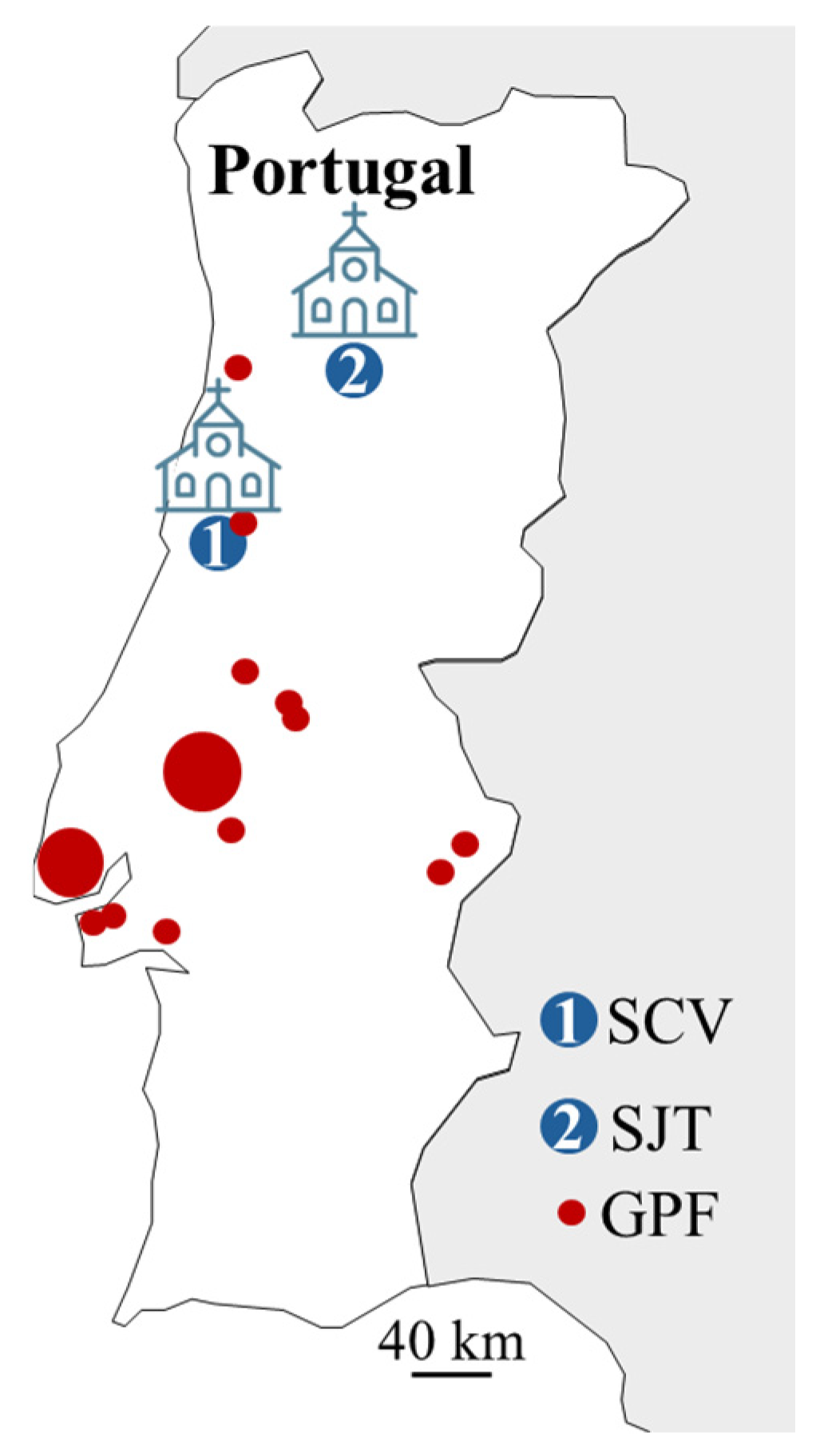

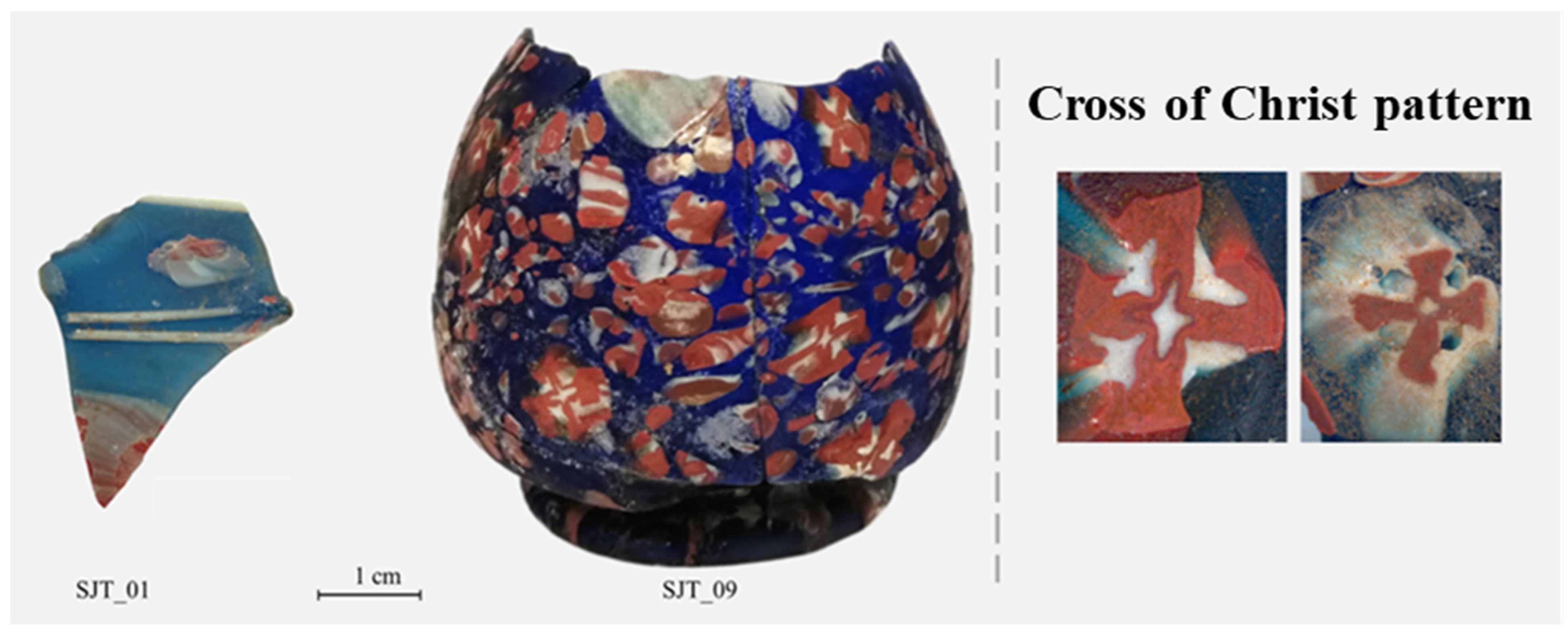

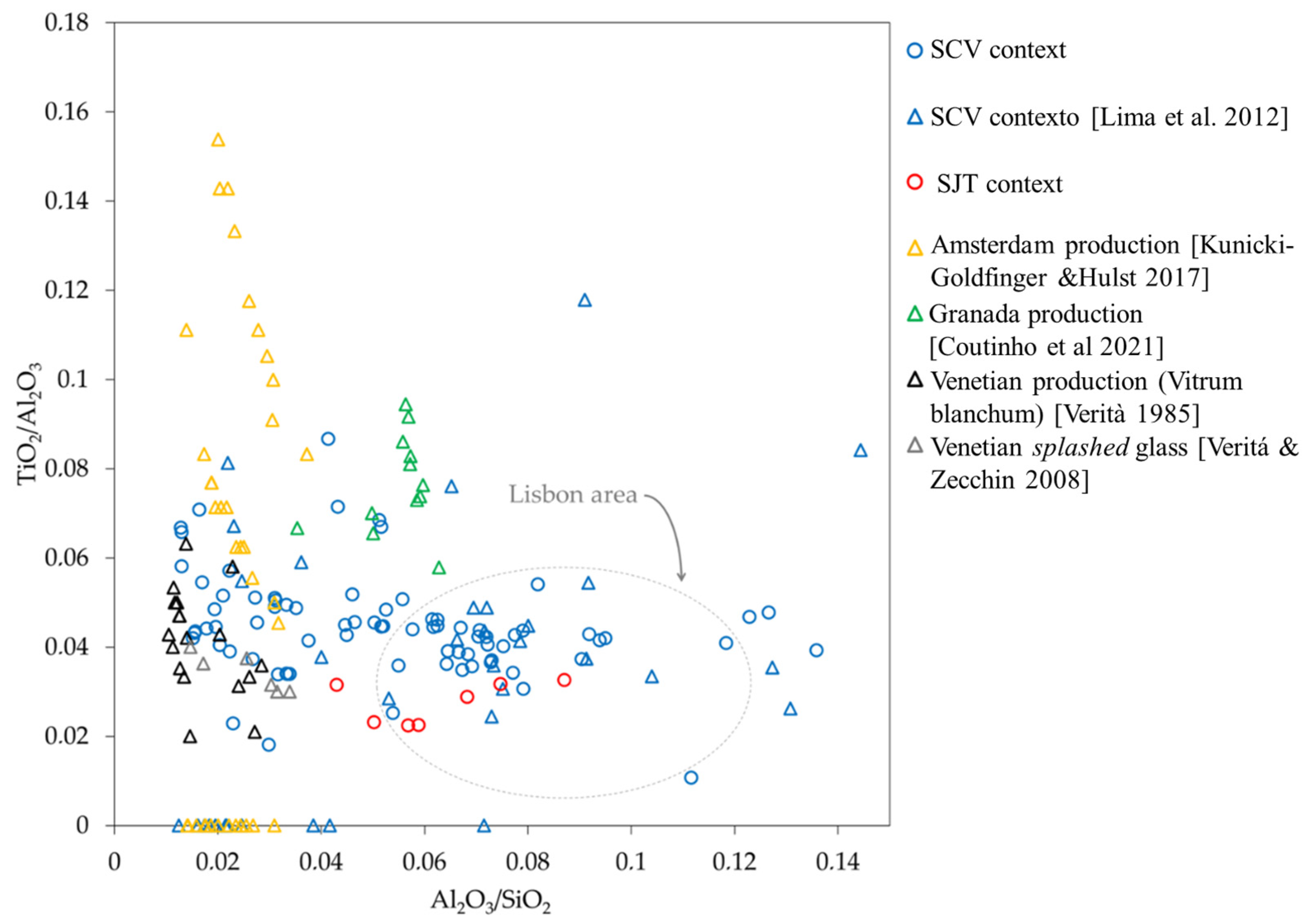
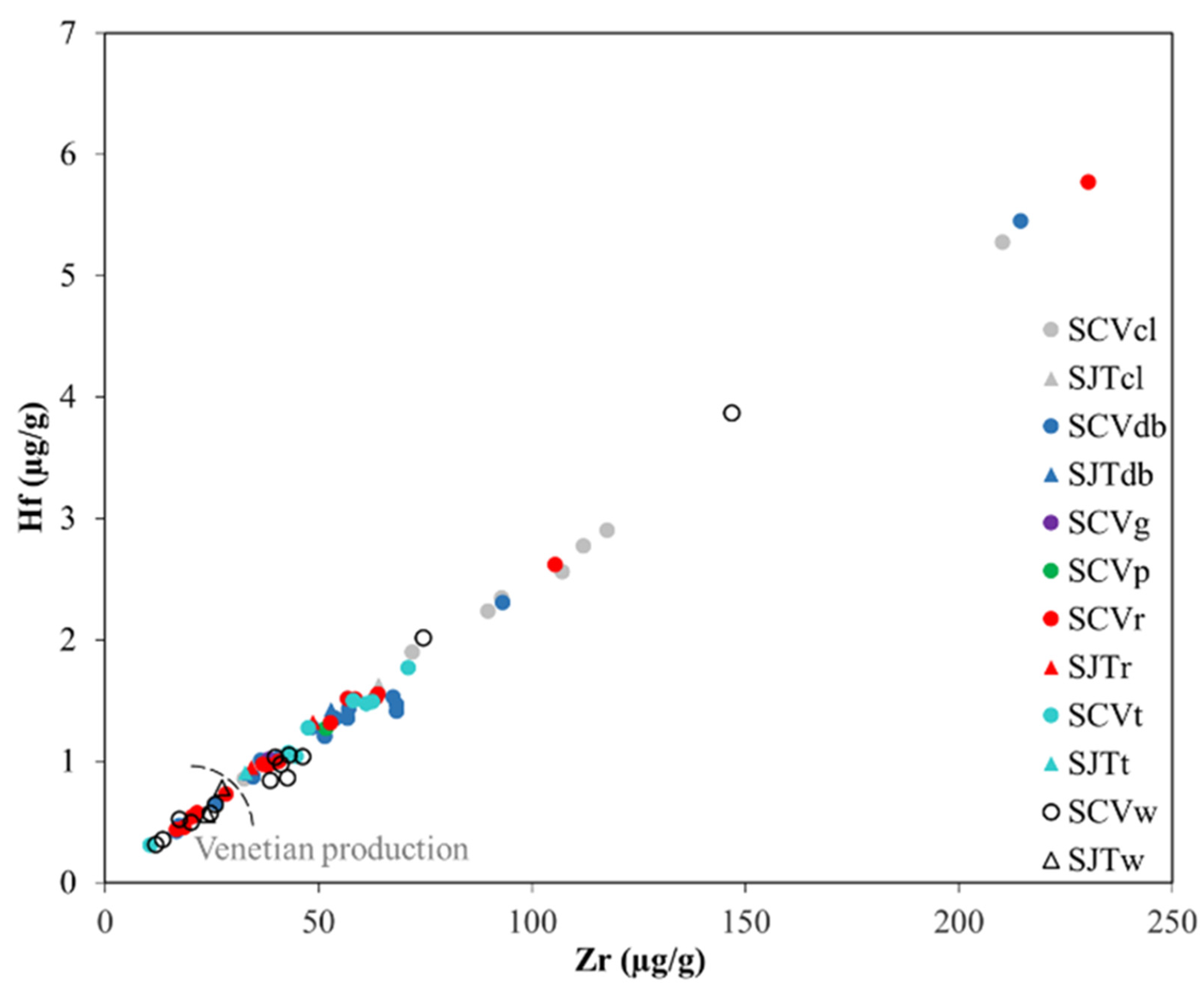
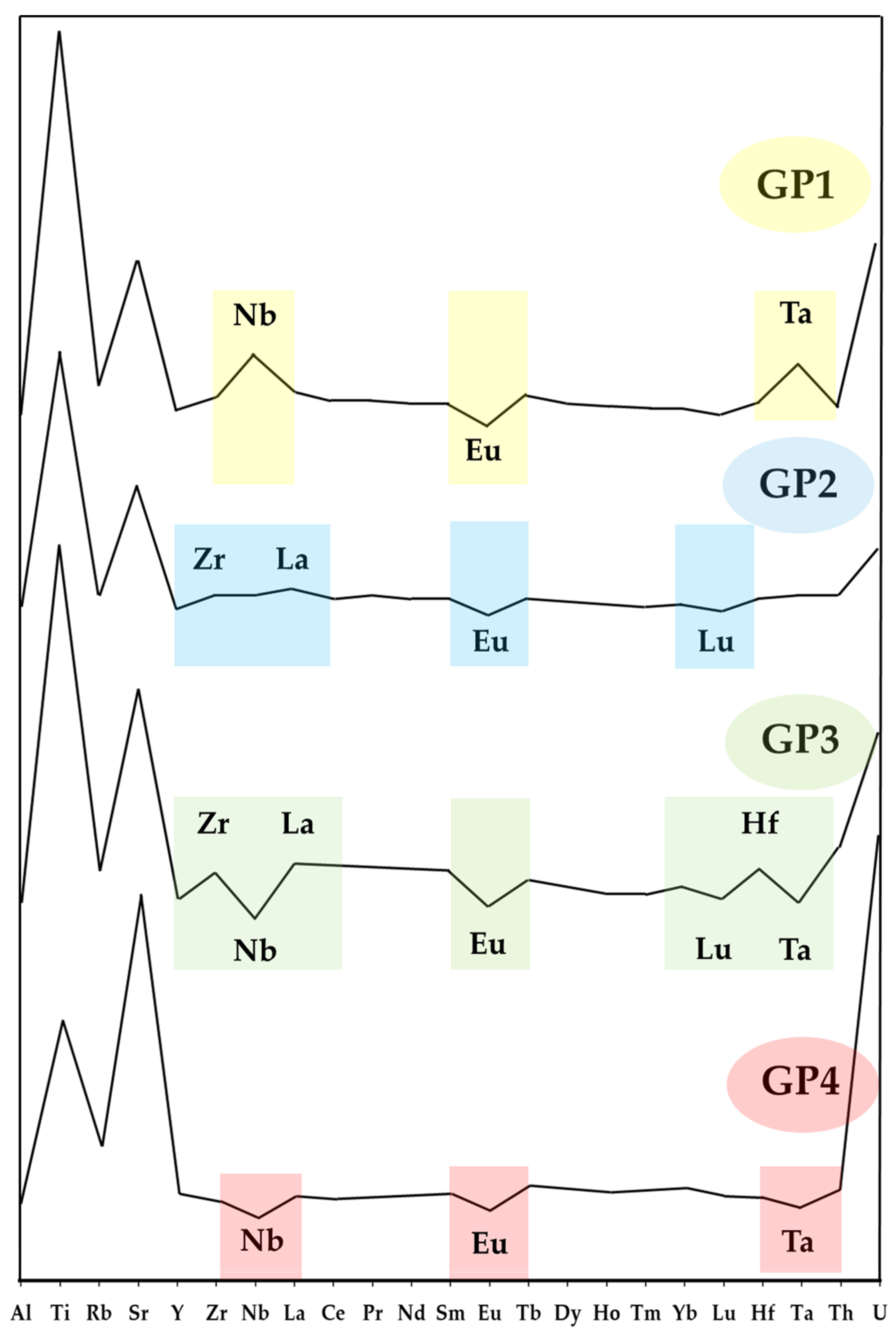
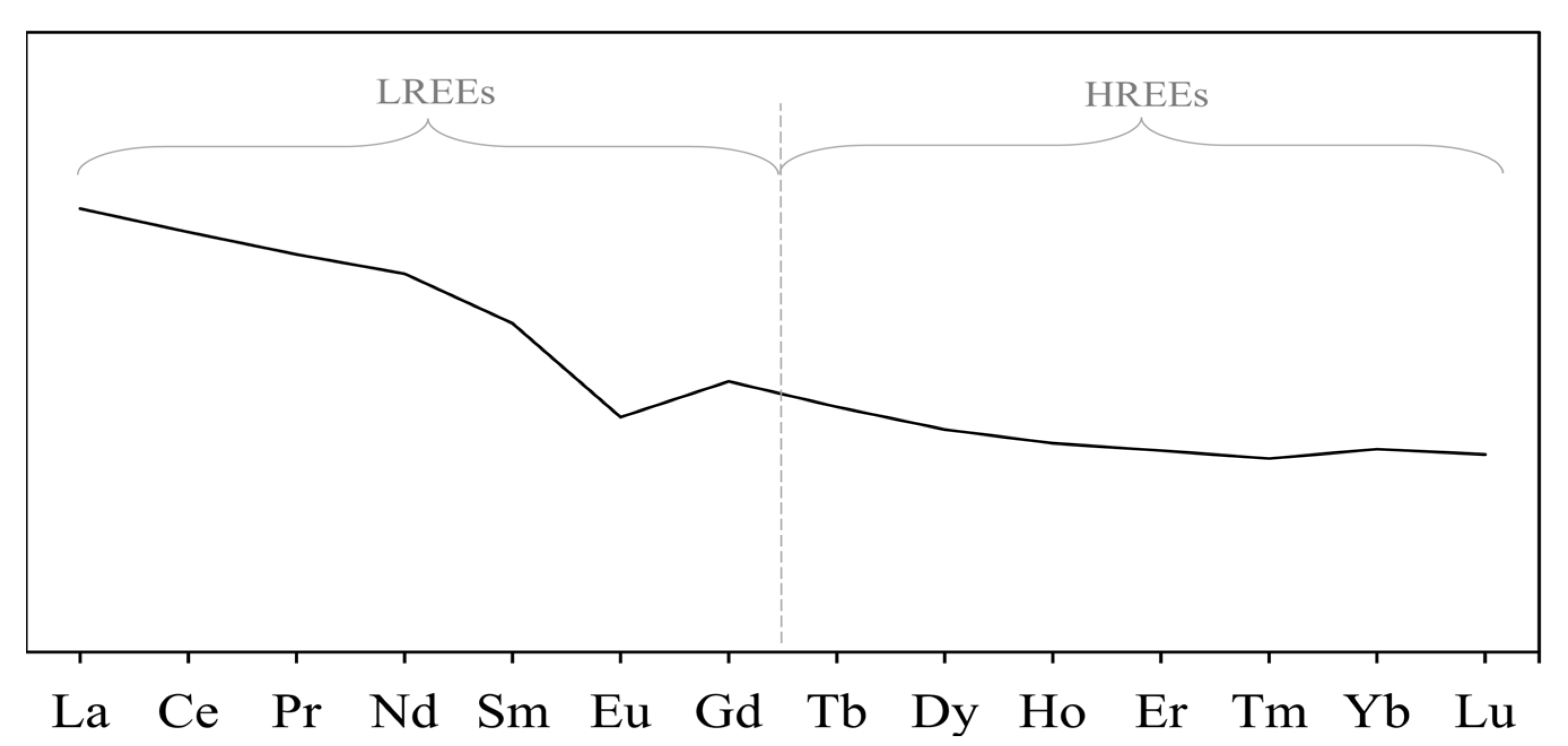


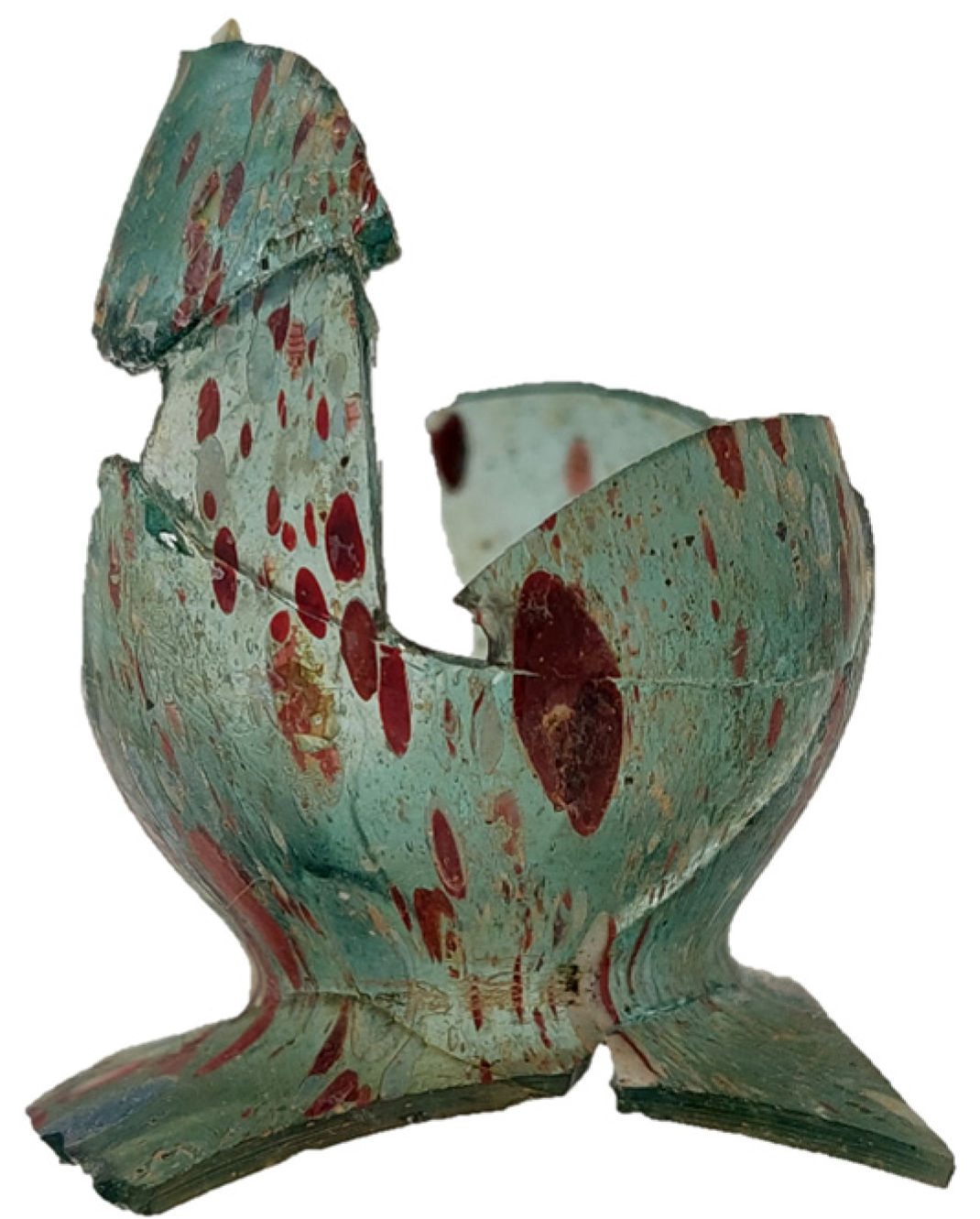
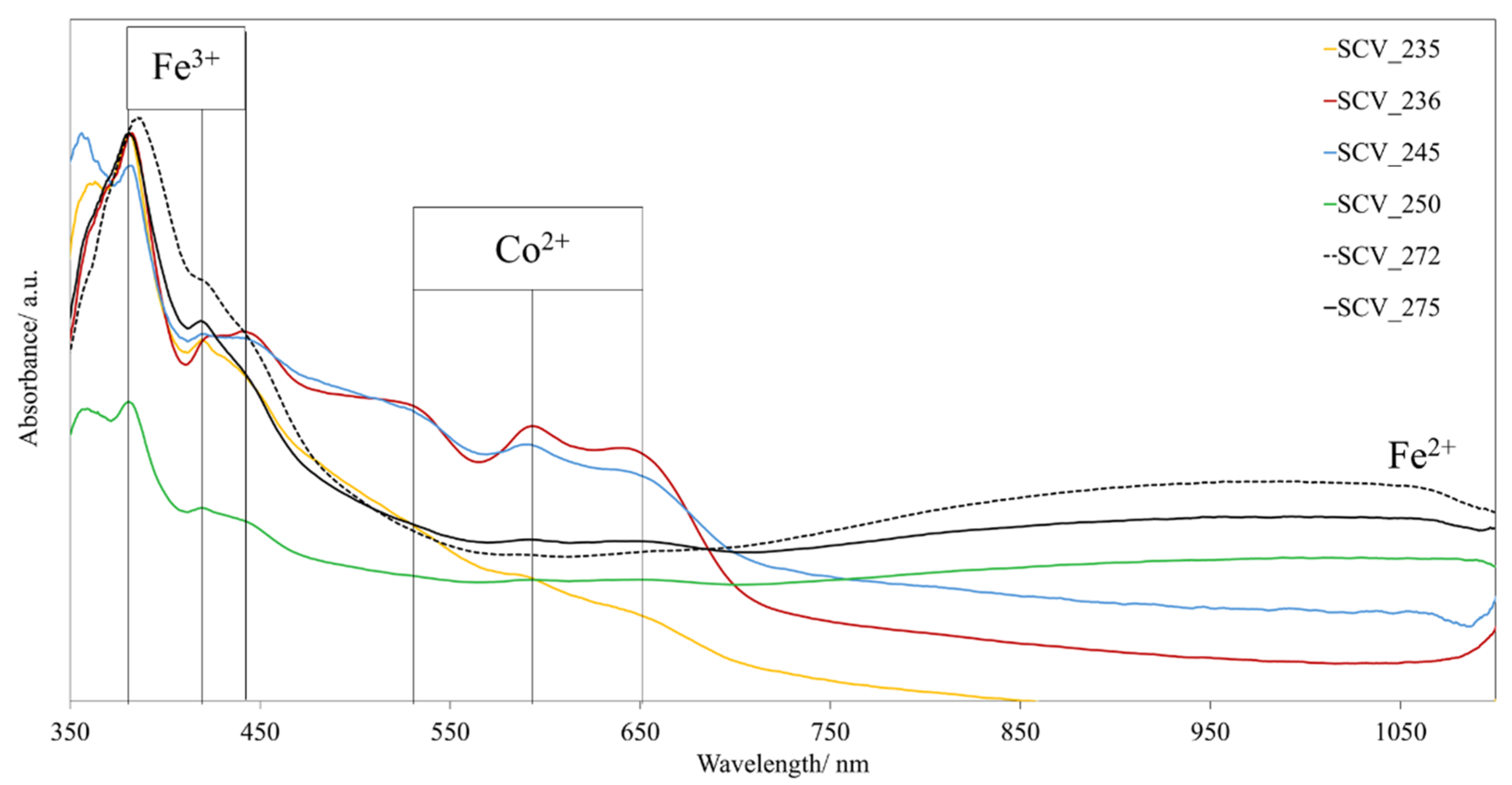

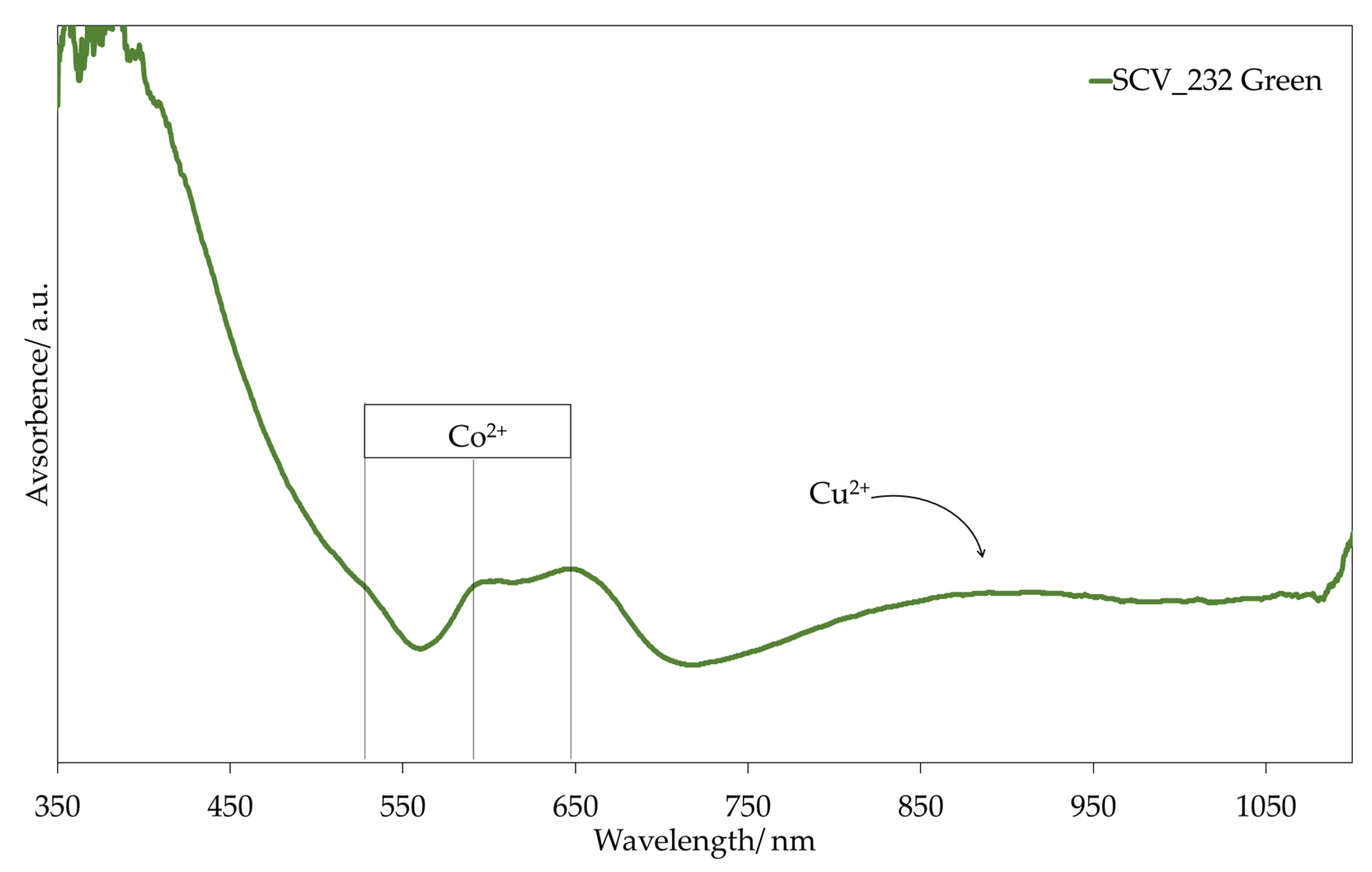

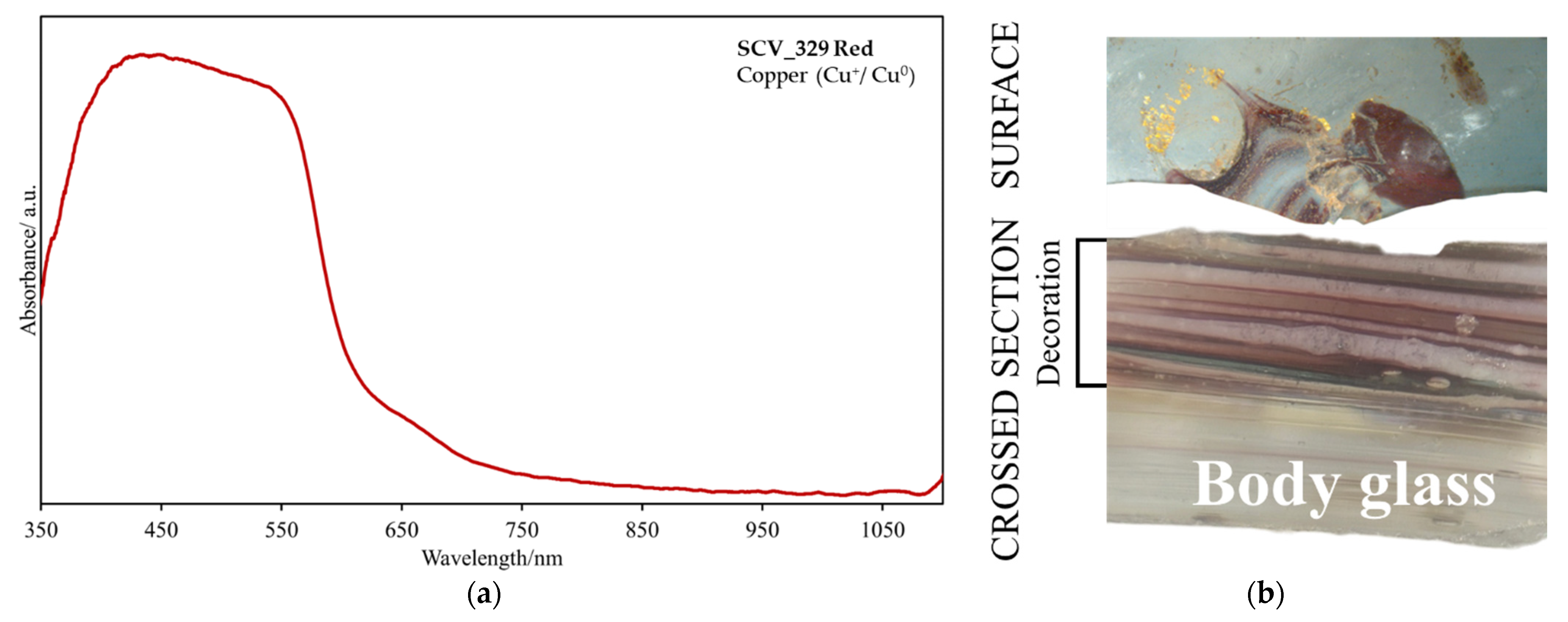
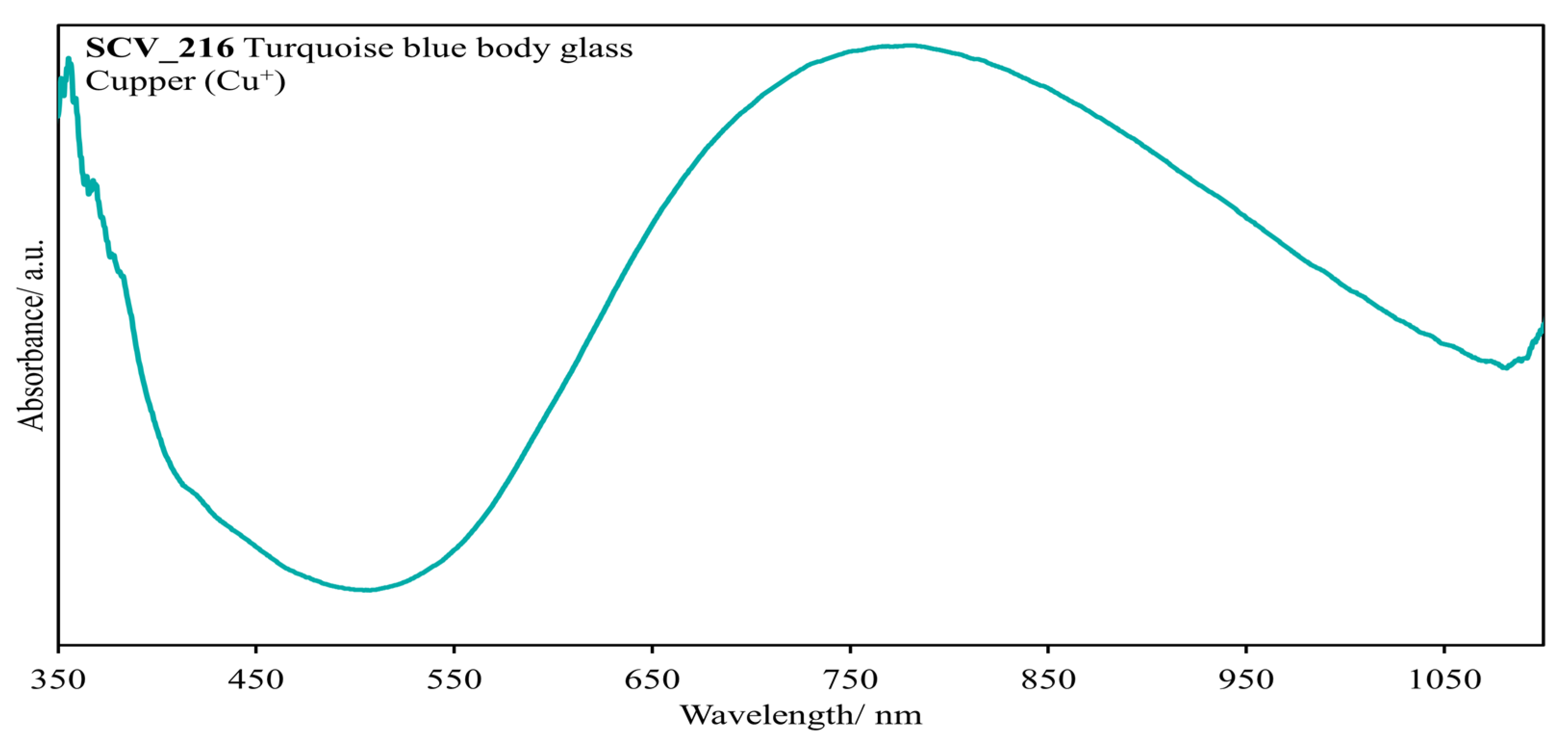

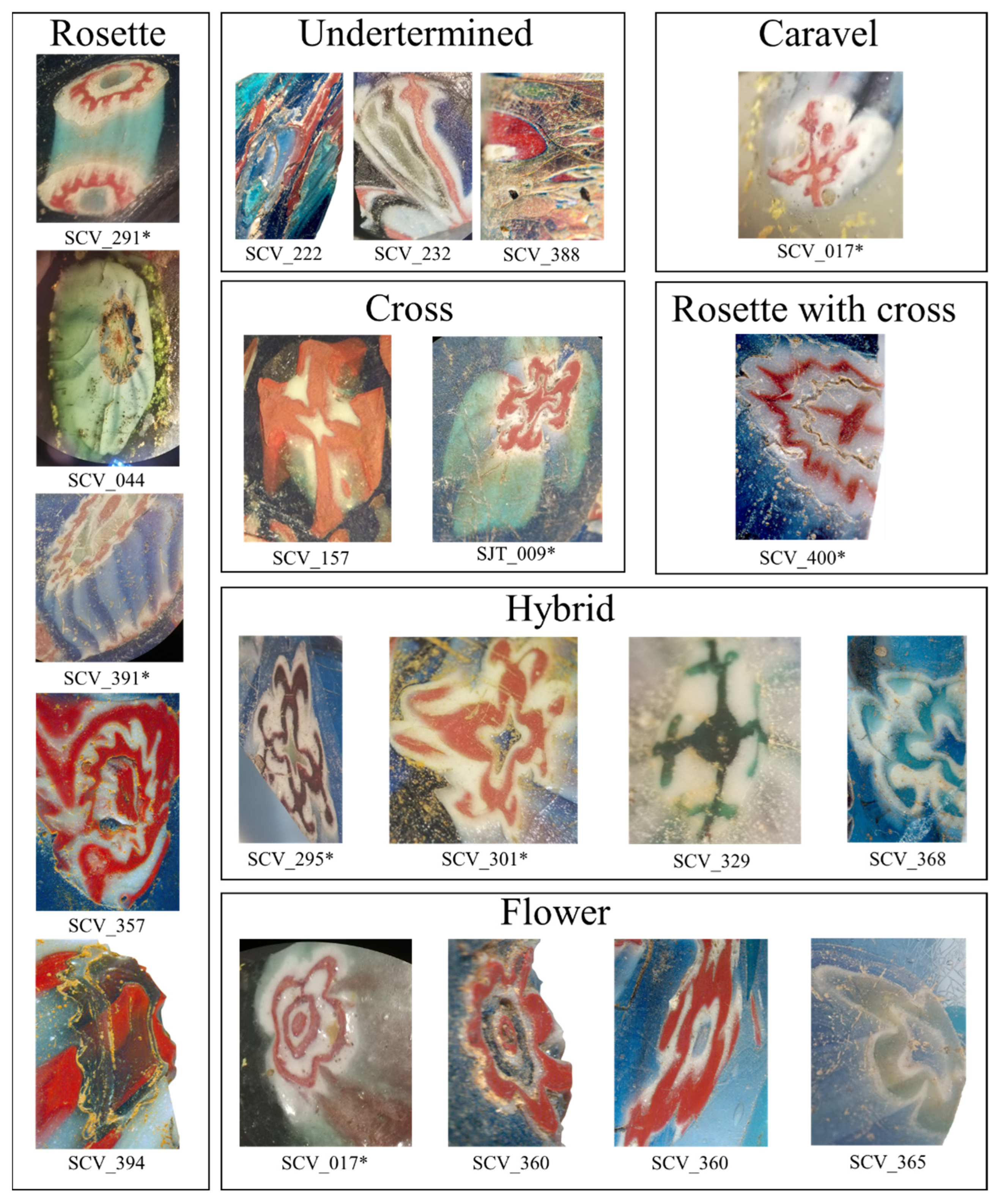
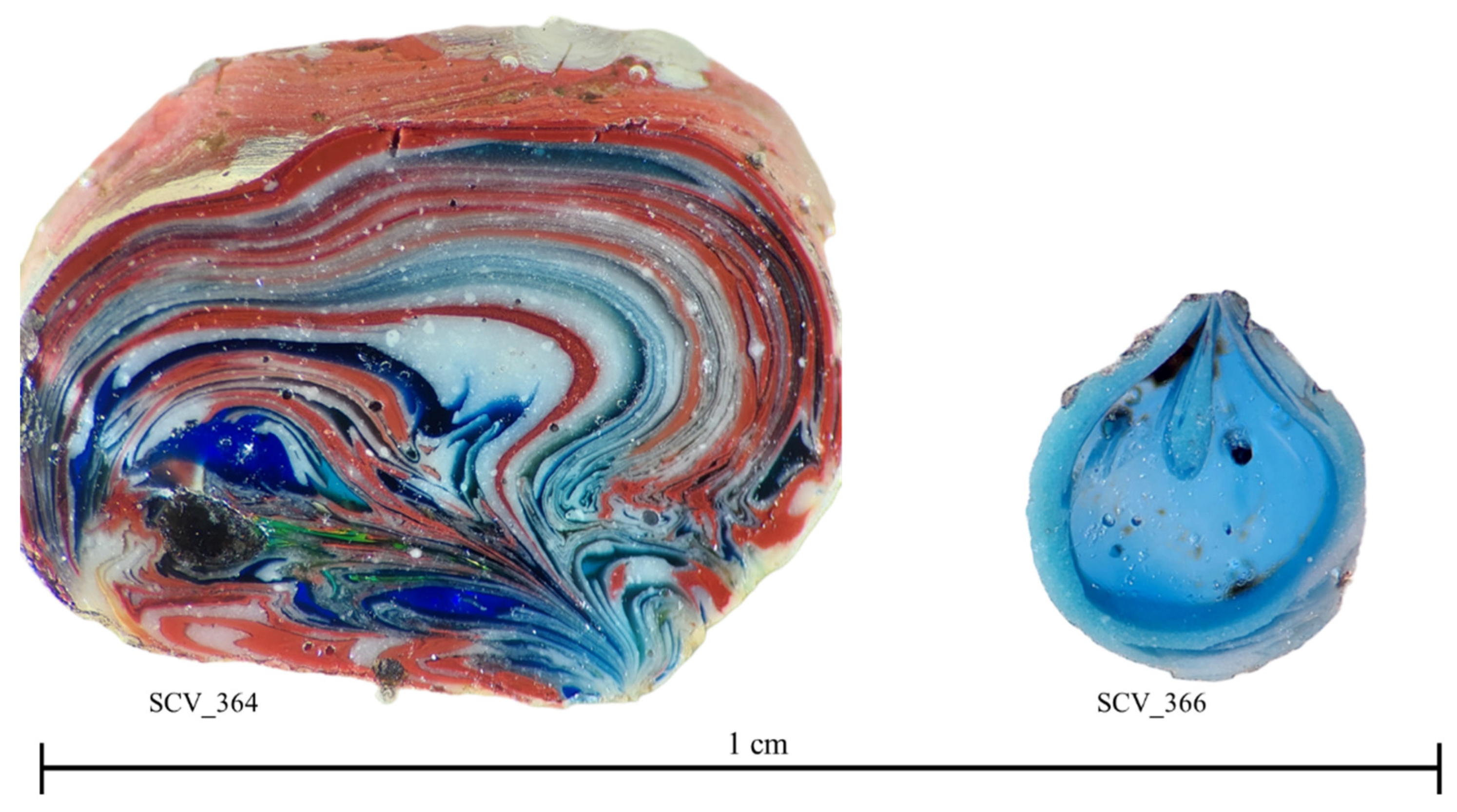
| Context | Nº Samples | Color | Type of Inf. | Na2O | MgO | Al2O3 | SiO2 | P2O5 | Cl | K2O | CaO | TiO2 |
|---|---|---|---|---|---|---|---|---|---|---|---|---|
| SCV | 19 | Blue (t) | Average | 16.0 | 2.9 | 3.2 | 63.3 | 0.35 | 0.96 | 4.21 | 7.50 | 0.14 |
| Blue (t) | Minimum | 11.0 | 1.9 | 0.9 | 31.3 | 0.22 | 0.68 | 2.22 | 4.53 | 0.05 | ||
| Blue (t) | Maximum | 18.8 | 3.6 | 7.0 | 70.0 | 0.48 | 1.28 | 7.46 | 10.18 | 0.29 | ||
| SJT | 2 | Blue (t) | Average | 13.4 | 3.65 | 3.95 | 59.9 | 0.375 | 0.67 | 7.41 | 10.63 | 0.11 |
| Blue (t) | Minimum | 12.7 | 3.6 | 3.5 | 59.1 | 0.33 | 0.65 | 7.34 | 9.73 | 0.08 | ||
| Blue (t) | Maximum | 14.0 | 3.7 | 4.4 | 60.6 | 0.42 | 0.69 | 7.48 | 11.52 | 0.14 | ||
| SCV | 9 | Clear (tp) | Average | 16.6 | 3.7 | 5.4 | 62.4 | 0.42 | 0.95 | 3.69 | 6.63 | 0.21 |
| Clear (tp) | Minimum | 14.2 | 1.9 | 1.6 | 57.0 | 0.23 | 0.7 | 0.73 | 3.33 | 0.07 | ||
| Clear (tp) | Maximum | 21.3 | 7.1 | 7.7 | 67.2 | 0.84 | 1.3 | 6.89 | 8.99 | 0.34 | ||
| SCV | 1 | Green (t) | -- | 11.1 | 3.2 | 2.2 | 66.7 | 0.26 | 0.85 | 5.01 | 10.48 | 0.08 |
| SCV | 1 | Purple (op) | -- | 15.9 | 2.7 | 3.4 | 65.8 | 0.48 | 0.88 | 3.92 | 6.74 | 0.15 |
| SCV | 15 | Red (op) | Average | 15.5 | 3.4 | 3.2 | 64.1 | 0.40 | 0.87 | 3.96 | 8.42 | 0.14 |
| Red (op) | Minimum | 11.1 | 2.7 | 1.2 | 58.1 | 0.28 | 0.72 | 2.38 | 6.73 | 0.05 | ||
| Red (op) | Maximum | 17.9 | 3.9 | 7.4 | 69.1 | 0.57 | 1.09 | 5.79 | 10.66 | 0.35 | ||
| SJT | 2 | Red (op) | Average | 14.5 | 3.5 | 3.9 | 60.5 | 0.39 | 0.67 | 7.14 | 9.43 | 0.10 |
| Red (op) | Minimum | 14.6 | 3.7 | 4.1 | 60.6 | 0.41 | 0.72 | 7.52 | 9.61 | 0.12 | ||
| Red (op) | Maximum | 14.3 | 3.3 | 3.6 | 60.3 | 0.36 | 0.62 | 6.76 | 9.25 | 0.08 | ||
| SCV | 9 | Turquoise (t) | Average | 15.3 | 3.1 | 3.2 | 65.7 | 0.36 | 0.95 | 4.20 | 7.38 | 0.12 |
| Turquoise (t) | Minimum | 10.0 | 2.0 | 1.0 | 62.3 | 0.28 | 0.63 | 2.94 | 6.22 | 0.04 | ||
| Turquoise (t) | Maximum | 18.5 | 4.6 | 5.2 | 70.1 | 0.43 | 1.18 | 6.73 | 9.29 | 0.18 | ||
| SJT | 1 | Turquoise (t) | -- | 12.9 | 3.7 | 5.1 | 58.4 | 0.38 | 0.78 | 7.29 | 11.29 | 0.17 |
| SCV | 14 | White (op) | Average | 16.2 | 2.75 | 2.8 | 65.4 | 0.45 | 1.24 | 3.94 | 7.02 | 0.14 |
| White (op) | Minimum | 11.2 | 1.6 | 0.9 | 61.4 | 0.29 | 0.71 | 2.27 | 4.21 | 0.04 | ||
| White (op) | Maximum | 19.4 | 3.5 | 5.9 | 69.9 | 0.90 | 2.22 | 5.67 | 10.17 | 0.25 | ||
| SJT | 2 | White (op) | Average | 14.5 | 3.6 | 2.9 | 62.3 | 0.36 | 0.965 | 6.69 | 8.7 | 0.08 |
| White (op) | Minimum | 13.9 | 3.5 | 2.7 | 61.9 | 0.34 | 0.87 | 6.03 | 8.47 | 0.07 | ||
| White (op) | Maximum | 15.0 | 3.7 | 3.1 | 62.6 | 0.38 | 1.06 | 7.35 | 8.93 | 0.09 |
| wt% | µg/g | |||||||||||||||||||||||||
|---|---|---|---|---|---|---|---|---|---|---|---|---|---|---|---|---|---|---|---|---|---|---|---|---|---|---|
| Context | Nº Layers | Color | Type of Inf. | Na2O | MgO | Al2O3 | SiO2 | P2O5 | Cl | K2O | CaO | TiO2 | MnO | Fe2O3 | CoO | NiO | CuO | ZnO | As2O3 | SnO2 | Sb2O3 | SrO | ZrO2 | BaO | PbO | Bi |
| SCV | 19 | B (t) | Average | 15.5 | 2.8 | 3.1 | 63.1 | 0.34 | 0.94 | 4.09 | 7.29 | 0.14 | 0.46 | 1.03 | 1692 | 510 | 1028 | 95 | 2354 | 2179 | <10 | 514 | 65 | 248 | 1486 | 1069 |
| B (t) | Minimum | 10.4 | 1.8 | 0.9 | 56.7 | 0.22 | 0.67 | 2.18 | 4.42 | 0.05 | 0.02 | 0.44 | 358 | 85 | 36 | 47 | 500 | 66 | <10 | 206 | 23 | 75 | 2.32 | 124 | ||
| B (t) | Maximum | 18.4 | 3.6 | 6.4 | 68.8 | 0.46 | 1.26 | 7.4 | 10.02 | 0.28 | 0.78 | 1.81 | 5118 | 1514 | 5906 | 197 | 6556 | 12,489 | 52 | 733 | 126 | 467 | 6531 | 5131 | ||
| SJT | 2 | B (t) | Average | 13.1 | 3.6 | 3.9 | 58.5 | 0.37 | 0.66 | 7.24 | 10.38 | 0.11 | 0.54 | 1.035 | 1240 | 385 | 150 | 150 | 2346 | 466 | <10 | 854 | 58 | 12 | 451 | 307 |
| B (t) | Minimum | 12.4 | 3.5 | 3.4 | 57.7 | 0.32 | 0.64 | 7.17 | 9.5 | 0.08 | 0.49 | 0.87 | 627 | 82 | 55 | 55 | 1806 | 187 | <10 | 737 | 46 | 12 | 210 | 109 | ||
| B (t) | Maximum | 13.7 | 3.6 | 4.3 | 59.2 | 0.41 | 0.67 | 7.3 | 11.26 | 0.14 | 0.59 | 1.2 | 1853 | 689 | 246 | 246 | 2887 | 745 | <10 | 971 | 71 | 12 | 692 | 506 | ||
| SCV | 9 | Cl (tp) | Average | 16.2 | 3.6 | 4.7 | 60.6 | 0.40 | 0.92 | 3.60 | 6.81 | 0.21 | 0.54 | 1.05 | 57 | 34 | 2101 | 77 | 202 | 7227 | <10 | 504 | 129 | 309 | 4813 | 57 |
| Cl (tp) | Minimum | 14 | 1.8 | 1.4 | 55.2 | 0.23 | 0.69 | 1.34 | 3.24 | 0.07 | 0.22 | 0.55 | 10 | 11 | 12 | 39 | 20 | 130 | <10 | 240 | 33 | 131 | 10 | 26 | ||
| Cl (tp) | Maximum | 20.2 | 6.8 | 7.5 | 64.7 | 0.81 | 1.26 | 6.77 | 8.83 | 0.32 | 1.07 | 2.11 | 185 | 92 | 9500 | 132 | 544 | 29,433 | <10 | 660 | 284 | 443 | 26,083 | 88 | ||
| SCV | 1 | G (t) | -- | 17.5 | 3.1 | 2.2 | 65.1 | 0.25 | 0.83 | 4.88 | 10.21 | 0.07 | 0.4 | 0.94 | 163 | 69 | 2287 | 65 | 264 | 4236 | 19 | 551 | 54 | 231 | 3489 | 178 |
| SCV | 1 | P (op) | -- | 16.2 | 2.6 | 3.3 | 63.6 | 0.47 | 0.85 | 3.79 | 6.52 | 0.15 | 0.76 | 1.34 | 2998 | 847 | 473 | 189 | 3220 | 735 | <10 | 528 | 70 | 458 | 533 | 1489 |
| SCV | 15 | R (op) | Average | 14.0 | 3.1 | 3.1 | 58.7 | 0.37 | 0.81 | 3.53 | 7.10 | 0.13 | 0.37 | 3.19 | 193 | 101 | 11,514 | 221 | 420 | 13,906 | 34 | 494 | 107 | 184 | 17,031 | 170 |
| R (op) | Minimum | 10.2 | 2.8 | 1.1 | 55.2 | 0.26 | 0.64 | 2.02 | 6.39 | 0.05 | 0.02 | 0.98 | 20 | 29 | 4640 | 32 | 52 | 484 | 26 | 286 | 23 | 76 | 516 | 11 | ||
| R (op) | Maximum | 16.8 | 3.5 | 7.1 | 64.4 | 0.55 | 0.99 | 5.26 | 9.48 | 0.34 | 0.77 | 4.70 | 741 | 363 | 24,732 | 2158 | 1696 | 47,149 | 41 | 714 | 466 | 354 | 60,600 | 1039 | ||
| SJT | 2 | R (op) | Average | 13.7 | 3.4 | 3.7 | 57.5 | 0.37 | 0.64 | 6.80 | 9.10 | 0.10 | 0.45 | 3.15 | 63 | 29 | 9902 | 59 | 157 | 671 | 52 | 637 | 56 | 260 | 671 | 26 |
| R (op) | Minimum | 13.5 | 3.2 | 3.4 | 57.3 | 0.34 | 0.59 | 6.44 | 8.80 | 0.08 | 0.44 | 2.71 | 59 | 28 | 6488 | 50 | 97 | 629 | 30 | 582 | 46 | 253 | 651 | 17 | ||
| R (op) | Maximum | 13.9 | 3.5 | 3.9 | 57.7 | 0.39 | 0.69 | 7.15 | 9.13 | 0.11 | 0.46 | 3.58 | 68 | 31 | 13,316 | 69 | 217 | 714 | 114 | 692 | 66 | 267 | 691 | 36 | ||
| SCV | 9 | T (t) | Average | 14.2 | 2.6 | 2.9 | 61.0 | 0.34 | 0.94 | 3.91 | 6.75 | 0.12 | 0.33 | 0.80 | 704 | 226 | 30,335 | 83 | 902 | 3185 | 160 | 499 | 63 | 172 | 12,961 | 387 |
| T (t) | Minimum | 9.0 | 1.6 | 0.7 | 55.4 | 0.23 | 0.57 | 2.43 | 5.52 | 0.03 | 0.02 | 0.01 | 30 | 33 | 1185 | 51 | 50 | 11 | 16 | 319 | 15 | 75 | 276 | 15 | ||
| T (t) | Maximum | 17.7 | 3.3 | 4.7 | 67.3 | 0.42 | 1.6 | 6.09 | 8.7 | 0.17 | 0.77 | 1.55 | 5153 | 1483 | 79,704 | 126 | 6805 | 20,708 | 385 | 592 | 96 | 279 | 88,852 | 3197 | ||
| SJT | 1 | T (t) | -- | 12.6 | 3.6 | 5 | 56.9 | 0.37 | 0.76 | 7.1 | 11 | 0.16 | 0.57 | 1.39 | 777 | 70 | 480 | 22 | 1942 | 212 | 236 | 915 | 87 | 251 | 446 | 79 |
| SCV | 14 | W (op) | Average | 11.4 | 2.0 | 1.9 | 46.4 | 0.32 | 0.86 | 2.8 | 5.05 | 0.09 | 0.26 | 0.58 | 53 | 52 | 3131 | 61 | 177 | 13 | 71 | 346 | 56 | 118 | 14 | 70 |
| W (op) | Minimum | 8.0 | 1.1 | 0.6 | 37.2 | 0.21 | 0.55 | 1.91 | 2.36 | 0.03 | 0.07 | 0.33 | 12 | 22 | 115 | 21 | 37 | <10 | 24 | 168 | 16 | 63 | <10 | 10 | ||
| W (op) | Maximum | 14.9 | 2.9 | 4.0 | 56.4 | 0.71 | 1.75 | 4.56 | 8.54 | 0.17 | 0.78 | 0.90 | 247 | 132 | 22,723 | 99 | 678 | 30 | 162 | 601 | 199 | 252 | 20 | 395 | ||
| SJT | 2 | W (op) | Average | 10.9 | 2.7 | 2.2 | 46.9 | 0.27 | 0.73 | 5.03 | 6.55 | 0.06 | 0.23 | 0.58 | 47 | 38 | 2259 | 41 | 205 | 9 | 81 | 468 | 34 | 143 | 13 | 30 |
| W (op) | Minimum | 10.3 | 2.6 | 2.1 | 45.9 | 0.26 | 0.65 | 4.61 | 6.47 | 0.05 | 0.22 | 0.57 | 42 | 30 | 113 | 36 | 190 | 7 | 78 | 455 | 32 | 143 | 12 | 17 | ||
| W (op) | Maximum | 11.5 | 2.8 | 2.3 | 47.9 | 0.28 | 0.81 | 5.45 | 6.62 | 0.06 | 0.23 | 0.58 | 52 | 47 | 4406 | 47 | 221 | 12 | 85 | 481 | 37 | 144 | 14 | 43 | ||
| GP | Nº | Analyzed Glass Layer |
| 1 | 4 | SCV_365 (Body db/w), SCV_368 (Body db/w) |
| 2 | 12 | SCV_216 (r/t/w), SCV_365 (db/t), SCV_368 (db/p/t), SCV_388 (Body db/r/t/w) |
| 3 | 30 | SCV_044 (cl/db/r/w), SCV_235 (cl), SCV_236 (cl), SCV_245 (cl/db/r/w), SCV_250 (cl/tb), SCV_275 (cl), SCV_329 (Body db/tb), SCV_357 (db/r), SCV_360 (Body db/db/r/w), SCV_369 (Body db/db/r/t/w), SCV_375 (Body db/r/w), SCV_394 (Body db) |
| 4 | 27 | SCV_046 (cl), SCV_232 (db/gr/r/w), SCV_235 (r), SCV_250 (db/r/w), SCV_272 (cl), SCV_275 (r), SCV_329 (r/w), SCV_364 (cl/db/r/t/w), SCV_366 (db/t), SCV_394 (cl), SJT_01 (Body db/r/t/w), SJT_09 (db/r/w) |
| Patterns | Samples | Alkali Sources (Na2O* vs. K2O*) | Silica Sources (SiO2/TiO2/Al2O3) | G P | Eu/Eu* |
|---|---|---|---|---|---|
| Splashed + rosette | SCV_0044 cl | Levant. (purified) | Near Lisbon region | 3 | 0.48 |
| SCV_0044 b | Mix. | Lisbon | 3 | 0.45 | |
| SCV_0044 r | Mix | Near Lisbon region | 3 | 0.49 | |
| SCV_0044 w | Mix. | Lisbon | 3 | 0.43 | |
| Splashed | SCV_0046 cl | Levant. (umpurified) | Near Lisbon region | 4 | 0.63 |
| Rosette | SVC_216 t | Mix. | Lisbon | 2 | 0.62 |
| SCV_216 R | F.d.V. | Lisbon | 2 | 0.33 | |
| SCV_216 w | Mix. | Two Roses | 2 | n/d. | |
| Indefinite | SVC_232 b | F.d.V. | Between Venetian and Two Roses | 4 | 0.57 |
| SCV_232 gr | F.d.V. | Venetian (Veritá and Zecchin 2008) | 4 | 0.56 | |
| SCV_232 r | F.d.V. | Venetian | 4 | 0.56 | |
| SCV_232 w | F.d.V. | Venetian | 4 | n/d. | |
| Splashed | SVC_235 cl | F.d.V. | Lisbon | 3 | 0.62 |
| SCV_235 r | Levant. (umpurified) | Between Venetian and Two Roses | 4 | 0.28 | |
| Splashed + rosette | SVC_236 cl | F.d.V. | Lisbon | 3 | 0.72 |
| Indefinite | SVC_245 cl | F.d.V. | Lisbon | 3 | 0.69 |
| SCV_245 b | Mix. | Lisbon | 3 | 0.61 | |
| SCV_245 r | F.d.V. | Lisbon | 3 | 0.51 | |
| SCV_245 w | F.d.V. | Lisbon | 3 | 0.29 | |
| Splashed + rosette | SVC_250 cl | Mix. | Lisbon | 3 | 0.52 |
| SCV_250 b | Levant. (umpurified) | Venetian | 4 | 0.70 | |
| SCV_250 r | F.d.V. | Venetian | 4 | 0.62 | |
| SCV_250 t | Levant. (umpurified) | Between Venetian and Two Roses | 3 | 0.60 | |
| SCV_250 w | F.d.V. | Between Venetian and Two Roses | 4 | 0.14 | |
| Splashed | SVC_272 cl | Levant. (umpurified) | Near Lisbon region | 4 | 0.70 |
| Splashed | SVC_275 cl | Levant. (purified) | Lisbon | 3 | 0.61 |
| SCV_275 r | Levant. (umpurified) | Venetian (Veritá and Zecchin 2008) | 4 | 0.70 | |
| Splashed + hybrid | SVC_329 b | F.d.V. | Lisbon | 3 | 0.53 |
| SCV_329 r | F.d.V. | Venetian | 4 | 0.47 | |
| SCV_329 t | F.d.V. | Lisbon | 3 | 0.43 | |
| SCV_329 w | F.d.V. | Venetian (Veritá and Zecchin 2008) | 4 | n/d. | |
| Rosette | SVC_357 b | Mix. | Lisbon | 3 | 0.62 |
| SCV_357 r | Mix. | Lisbon | 3 | 0.62 | |
| Flowers + hybrid | SVC_360 b | Mix. | Two Roses | 3 | 0.55 |
| SCV_360 b | Mix. | Two Roses | 3 | 0.57 | |
| SCV_360 r | Mix | Lisbon | 3 | 0.59 | |
| SCV_360 w | Mix. | Venetian (Veritá and Zecchin 2008) | 3 | n/d. | |
| Murrine cane | SCV_364 cl | F.d.V. | Venetian | 4 | 0.58 |
| SCV_364 b | F.d.V. | Venetian | 4 | 0.68 | |
| SCV_364 r | F.d.V. | Venetian | 4 | 0.64 | |
| SCV_364 t | F.d.V. | Venetian | 4 | 0.58 | |
| SCV_364 w | F.d.V. | Venetian | 4 | 0.93 | |
| Flowers | SVC_365 b | Levant. (purified) | Granada (Coutinho et al., 2021) | 1 | 0.78 |
| SCV_365 b | Mix. | Lisbon | 2 | 0.72 | |
| SCV_365 t | Mix. | Between Venetian and Two Roses | 2 | 0.65 | |
| SCV_365 w | Levant. (purified) | Between Two Roses and Granada | 1 | n/d. | |
| Murrine cane | SCV_0366 b | Levant. (umpurified) | Venetian | 4 | 0.77 |
| SCV_0366 t | F.d.V. | Venetian | 4 | 0.67 | |
| Flowers | SVC_368 b | Levant. (purified) | Granada (Coutinho et al., 2021) | 1 | 0.78 |
| SCV_368 b | Mix. | Lisbon | 2 | 0.65 | |
| SCV_368 p | Mix. | Lisbon | 2 | 0.59 | |
| SCV_368 t | Mix. | Between Venetian and Two Roses | 2 | 0.61 | |
| SCV_368 w | Levant. (purified) | Between Two Roses and Granada | 1 | n/d. | |
| Splashed + rosette | SVC_369 b | Mix. | Lisbon | 3 | 0.67 |
| SCV_369 b | Mix. | Lisbon | 3 | 0.66 | |
| SCV_369 r | Mix. | Lisbon | 3 | 0.54 | |
| SCV_369 t | Mix. | Lisbon | 3 | 0.50 | |
| SCV_369 w | Mix. | Lisbon | 3 | n/d. | |
| Rosette | SVC_375 b | Mix. | Lisbon | 3 | 0.69 |
| SCV_375 r | Mix. | Lisbon | 3 | 0.65 | |
| SCV_375 w | Mix. | Lisbon | 3 | 0.33 | |
| Indefinite + rosette | SVC_388 b | Mix. | Lisbon | 2 | 0.70 |
| SCV_388 r | Mix. | Lisbon | 2 | 0.66 | |
| SCV_388 t | Mix. | Lisbon | 2 | 0.66 | |
| SCV_388 w | Levant. (purified) | Lisbon | 2 | 0.18 | |
| Indefinite | SVC_394 b | Mix. | Between Venetian and Two Roses | 4 | 0.49 |
| SVC_394 cl | Levant. (purified) | Lisbon | 3 | 0.49 | |
| SVC_394 r | Mix. | Two Roses | - | 0.65 | |
| SVC_394 w | Levant. (purified) | Between Venetian and Two Roses | - | n/d. | |
| Rosette | SJT_001 b | F.d.V. | Lisbon | 4 | 0.52 |
| SJT_001 r | F.d.V. | Lisbon | 4 | 0.44 | |
| SJT_001 t | F.d.V. | Lisbon | 4 | 0.56 | |
| SJT_001 w | F.d.V. | Between Venetian and Lisbon | 4 | 0.61 | |
| Splashed + Rosette + Cross of Christ | SJT_009 b | F.d.V. | Lisbon | 4 | 0.50 |
| SJT_009 r | F.d.V. | Lisbon | 4 | 0.48 | |
| SJT_009 w | F.d.V. | Between Venetian and Lisbon | 4 | 0.17 |
Disclaimer/Publisher’s Note: The statements, opinions and data contained in all publications are solely those of the individual author(s) and contributor(s) and not of MDPI and/or the editor(s). MDPI and/or the editor(s) disclaim responsibility for any injury to people or property resulting from any ideas, methods, instructions or products referred to in the content. |
© 2024 by the authors. Licensee MDPI, Basel, Switzerland. This article is an open access article distributed under the terms and conditions of the Creative Commons Attribution (CC BY) license (https://creativecommons.org/licenses/by/4.0/).
Share and Cite
Valente, F.P.; Coutinho, I.; Medici, T.; Gratuze, B.; Alves, L.C.; Cadena, A.; Vilarigues, M. Provenance Studies of a Set of Pick-Up Glass Fragments Found in Portugal and Dated to the 17th Century. Heritage 2024, 7, 5048-5083. https://doi.org/10.3390/heritage7090239
Valente FP, Coutinho I, Medici T, Gratuze B, Alves LC, Cadena A, Vilarigues M. Provenance Studies of a Set of Pick-Up Glass Fragments Found in Portugal and Dated to the 17th Century. Heritage. 2024; 7(9):5048-5083. https://doi.org/10.3390/heritage7090239
Chicago/Turabian StyleValente, Francisca Pulido, Inês Coutinho, Teresa Medici, Bernard Gratuze, Luís C. Alves, Ana Cadena, and Márcia Vilarigues. 2024. "Provenance Studies of a Set of Pick-Up Glass Fragments Found in Portugal and Dated to the 17th Century" Heritage 7, no. 9: 5048-5083. https://doi.org/10.3390/heritage7090239
APA StyleValente, F. P., Coutinho, I., Medici, T., Gratuze, B., Alves, L. C., Cadena, A., & Vilarigues, M. (2024). Provenance Studies of a Set of Pick-Up Glass Fragments Found in Portugal and Dated to the 17th Century. Heritage, 7(9), 5048-5083. https://doi.org/10.3390/heritage7090239









